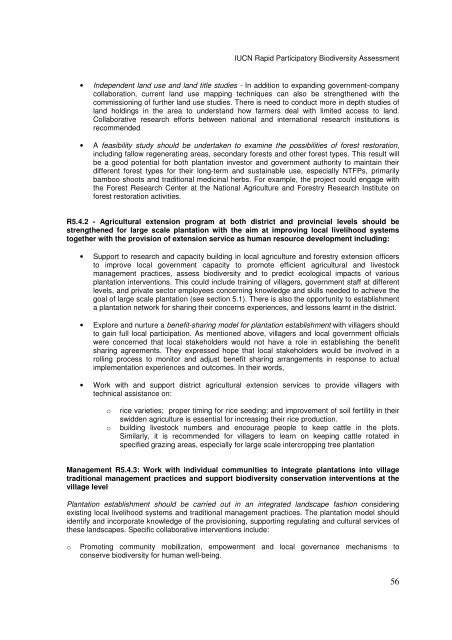Part 1 – A Rapid Participatory Biodiversity Assessment - IUCN
Part 1 – A Rapid Participatory Biodiversity Assessment - IUCN
Part 1 – A Rapid Participatory Biodiversity Assessment - IUCN
You also want an ePaper? Increase the reach of your titles
YUMPU automatically turns print PDFs into web optimized ePapers that Google loves.
<strong>IUCN</strong> <strong>Rapid</strong> <strong>Part</strong>icipatory <strong>Biodiversity</strong> <strong>Assessment</strong><br />
• Independent land use and land title studies - In addition to expanding government-company<br />
collaboration, current land use mapping techniques can also be strengthened with the<br />
commissioning of further land use studies. There is need to conduct more in depth studies of<br />
land holdings in the area to understand how farmers deal with limited access to land.<br />
Collaborative research efforts between national and international research institutions is<br />
recommended<br />
• A feasibility study should be undertaken to examine the possibilities of forest restoration,<br />
including fallow regenerating areas, secondary forests and other forest types. This result will<br />
be a good potential for both plantation investor and government authority to maintain their<br />
different forest types for their long-term and sustainable use, especially NTFPs, primarily<br />
bamboo shoots and traditional medicinal herbs. For example, the project could engage with<br />
the Forest Research Center at the National Agriculture and Forestry Research Institute on<br />
forest restoration activities.<br />
R5.4.2 - Agricultural extension program at both district and provincial levels should be<br />
strengthened for large scale plantation with the aim at improving local livelihood systems<br />
together with the provision of extension service as human resource development including:<br />
• Support to research and capacity building in local agriculture and forestry extension officers<br />
to improve local government capacity to promote efficient agricultural and livestock<br />
management practices, assess biodiversity and to predict ecological impacts of various<br />
plantation interventions. This could include training of villagers, government staff at different<br />
levels, and private sector employees concerning knowledge and skills needed to achieve the<br />
goal of large scale plantation (see section 5.1). There is also the opportunity to establishment<br />
a plantation network for sharing their concerns experiences, and lessons learnt in the district.<br />
• Explore and nurture a benefit-sharing model for plantation establishment with villagers should<br />
to gain full local participation. As mentioned above, villagers and local government officials<br />
were concerned that local stakeholders would not have a role in establishing the benefit<br />
sharing agreements. They expressed hope that local stakeholders would be involved in a<br />
rolling process to monitor and adjust benefit sharing arrangements in response to actual<br />
implementation experiences and outcomes. In their words,<br />
• Work with and support district agricultural extension services to provide villagers with<br />
technical assistance on:<br />
o rice varieties; proper timing for rice seeding; and improvement of soil fertility in their<br />
swidden agriculture is essential for increasing their rice production.<br />
o building livestock numbers and encourage people to keep cattle in the plots.<br />
Similarly, it is recommended for villagers to learn on keeping cattle rotated in<br />
specified grazing areas, especially for large scale intercropping tree plantation<br />
Management R5.4.3: Work with individual communities to integrate plantations into village<br />
traditional management practices and support biodiversity conservation interventions at the<br />
village level<br />
Plantation establishment should be carried out in an integrated landscape fashion considering<br />
existing local livelihood systems and traditional management practices. The plantation model should<br />
identify and incorporate knowledge of the provisioning, supporting regulating and cultural services of<br />
these landscapes. Specific collaborative interventions include:<br />
o Promoting community mobilization, empowerment and local governance mechanisms to<br />
conserve biodiversity for human well-being.<br />
56

















